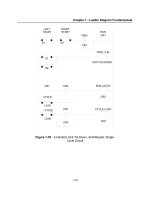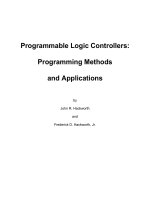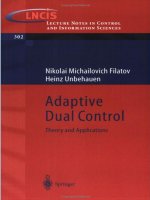1b semiconductors diodes and applications
Bạn đang xem bản rút gọn của tài liệu. Xem và tải ngay bản đầy đủ của tài liệu tại đây (6.82 MB, 189 trang )
OVERALL INTRODUCTION TO
ELECTRONIC/SEMI SWITCHES
●
●
●
●
●
Diodes
BJT
FET/MOSFET
Electronic Switches
Power JFET
Thyristors (4 layer pnpn)
●
Shockley diodes
●
●
●
●
●
SCS (Silicon controlled switches)
RCT (Reverse-conducting thyristors)
SITH (Static induction thyristors)
LASCR (Light activated SCR)
GTO (Gate Turn-off thyristors)
●
●
●
●
●
IGCT (Insulated gate-commutated thyristors)
FET-CTH (FET-controlled thyristors)
FCT (Field-controlled thyristors)
MCT (MOS-controlled thyristors)
ETO (Emitter turn-off thyristors)
● SCR (Silicon controlled rectifiers)
● DIAC/TRIAC
●
●
●
●
●
IGBT (Insulated Gate Bipolar Transistors)
PIC (High Voltage (Power) Integrated Circuits)
UJT (Uni-Junction Transistors)
PUT (Programmable Unijunction Transistors)
Other devices: Leds, Photovoltaic, Photoconductive, Photodiodes,
Phototransistor/Optical Couplers
Switch Types
Power Semiconductor Devices, their
Symbols & Characteristics
DEVICE SYMBOLS & CHARACTERISTICS
Switches Classification
● Semiconductor devices can be categorized into 3 types
based on their control input requirements:
● Current-driven devices – BJTs, MDs, GTOs
● Voltage-driven devices – MOSFETs, IGBTs, MCTs
● Pulse-driven devices – SCRs, TRIACs
● Can be categorised into three groups:
● Uncontrolled: Diodes - on/off determined by the power
circuit
● Semi-controlled: Thyristors (SCRs, Triacs, ...) - latched on by a
control signal but turned off by the power circuit.
● Fully controlled: Transistors: e.g. BJT, MOSFET, IGBT, GTO,
IGCT - turned on and off by control signals.
Switches Classification
● 1. Uncontrolled turn on and off (Diodes)
● 2. Controlled turn on uncontrolled turn off (Thyristors)
● 3. Controlled turn on and off characteristic (Transistors: BJT,
MOSFET, IGBT, GTO)
● 4. Continuous gate signal requirement (BJT, MOSFET, IGBT)
● 5. Pulse gate requirement (SCR, DIAC, TRIAC, GTO)
● 6. Bipolar voltage-withstanding capability (SCR, GTO)
● 7. Unipolar voltage-withstanding capability (BJT, MOSFET, IGBT,
GTO)
● 8. Bidirectional current capability (TRIAC)
● 9. Undirectional current capability (SCR, BJT, MOSFET, IGBT,
GTO)
The insulated-gate bipolar transistor or
IGBT is a three-terminal power
semiconductor device, noted for high
efficiency and fast switching.
The Integrated Gate Commutated Thyristor (IGCT) is a new
high-power semiconductor device. An IGCT is a sub family of
the GTO thyristor and like the GTO thyristor is a fullycontrollable power switch.
Thyristors thyristoren
Ideal vs. Practical Switches
Switch Application
● Static applications
● Involves non-rotating or moving mechanical
components.
● Examples:
● DC Power supply, Un-interruptible power supply, Power
generation and transmission (HVDC), Electroplating,
Welding, Heating, Cooling, Electronic ballast
● Drive applications
● Intimately contains moving or rotating components
such as motors.
● Examples:
● Electric trains, Electric vehicles, Air-conditioning System,
Pumps, Compressor, Conveyer Belt (Factory automation).
Application summary (1)
● In analog circuits , transistors are used in amplifiers , audio
amplifiers, radio frequency amplifiers, regulated power
supplies , and in computer PSU s, especially in switching
power supplies
● Transistors are ... used in digital circuits where they function
similarly to electrical switches. Digital circuits include logic
gates , RAM (random access memory) and
microprocessors .
● Oscillating Circuits
● Sensors
● Darlington
● Motor drive – traction drives (dc and ac), e.g., 400 – 3000V
with IGBT
● Utility interfaces – AC-DC, UPS, VAr compensation (e.g.,
IGBT)
● Unity power factor converters (e.g., IGBT)
Application summary (2)
● Switching
● Switch for a digital signal: BJT or MOSFET
● Switch for a analog signal: JFET
● Switch for a power signal: Power MOSFET or BJT
● Switched-mode power supplies
● Amplification
● Current controlled-current amplifier: BJT
● Voltage controlled-current amplifier: JFET or
MOSFET
● Motor drive
● Voltage motor drives (AC and DC), typically below a
few hundred volts.
● Synchronous rectification.
Device Applications
Ideal and Non-ideal Switches
● Forward conduction loss
● Ideal switch:
● Zero voltage drop across it during turn-on (Von).
● Although the forward current ( Ion ) may be large, the losses on the switch is
zero.
● Real switch:
● Exhibits forward conduction voltage (on state) (between 1-3V, depending on
type of switch) during turn on.
● Losses is measured by product of volt-drop across the device Von with the
current, Ion, averaged over the period.
● Major loss at low frequency and DC
Ideal and Non-ideal Switches
● Blocking state loss
● During turn-off, the switch blocks large voltage.
● Ideally no current should flow through the switch. But for real switch a small amount of
leakage current may flow. This creates turn-off or blocking state losses
● The leakage current during turn-off is normally very small, Hence the turn-off losses are
usually neglected.
● Switching loss
● Ideal switch:
● During turn-on and turn off, ideal switch requires zero transition time. Voltage and current are
switched instantaneously.
● Power loss due to switching is zero
● Real switch:
● During switching transition, the voltage requires time to fall and the current requires time to rise.
● The switching losses is the product of device voltage and current during transition.
● Major loss at high frequency operation
Ideal Switches
● Accept voltages of both polarities
● Both negative and positive
● Accept currents of both polarities
● Both negative and positive
● No breakdown voltage
● Perfect isolation in off state
● Zero on-resistance
● No voltage drop over the switch
● No switch delay
● Zero energy switching
● No power dissipated during
operation
Non-Ideal Switches
● Switching frequency
fs = 1/Ts (Hz) where Ts = switching
period (sec)
● Linear model
● Rise and fall time
on both V and I
● Voltage drop Von
● I0 models an
inductor
● Power loss!
Non-Ideal Switches
● During turn-on transition
●
●
●
●
td(on) = turn on delay time
tri = current rise time
tfv = voltage fall time
td(on)= tri + tfv = turn on crossover
time
● During turn-off transition
●
●
●
●
td(off) = turn off delay time
tfi = current fall time
trv = voltage rise time
td(off)= tfi + trv = turn off crossover
time
Non-Ideal Switches
Non-ideal Switch Power
Non-Ideal Switches: Dead Time
● Both switches located on each
leg of inverter cannot be
turned on at the same time.
● Otherwise a short through or
cross conduction on current
through the leg happens.
● Practically, a dead time (few
µsec for fast switching devices)
is introduced to make sure the
upper and lower switched not
turn on simultaneously.









